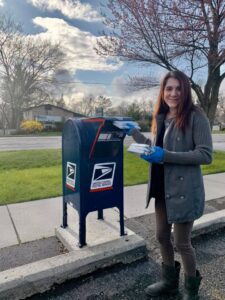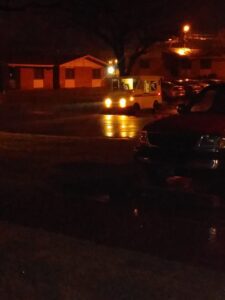In the complex web of USPS logistics, the promise of expected delivery by 9 pm often clashes with the reality of packages marked as “in transit.” This term, while indicating movement, doesn’t necessarily mean your parcel is “out for delivery.” As someone who regularly relies on USPS for timely deliveries, I’ve experienced this gap between expectation and actual service. It’s a peculiar dance of anticipation, where you’re informed that your item is on its way, yet as the clock ticks closer to 9 pm, the likelihood of receiving that eagerly awaited package dwindles, leaving you in a limbo of uncertainty.
The Reality of USPS Delivery Times

Navigating the world of USPS logistics reveals a landscape where delivery by 9pm is more an aspiration than a guarantee. The tracking website becomes a daily visit, often displaying tracking updates that shift from confidence to concern. Personal experience has taught me that shipping time is a fluid concept, subject to unusual circumstances beyond mere scheduling.
For instance, arriving late or a delivery date change is not just a minor inconvenience but a symptom of deeper issues. Traffic jams, staffing fluctuations, and even severe weather conditions play significant roles. There’s a certain helplessness that sets in, especially when your package is marked usps preparing for delivery, yet remains stalled due to changes in carrier route or maintenance issues. This often leads to frustration, especially when the promised tomorrow turns into a string of tomorrows.
The takeaway from these experiences is an understanding of the complexity behind each delivery by 9pm promise. Natural disasters and other unpredictable events remind us of the inherent uncertainty in logistics. Despite our reliance on the accuracy of modern shipping networks, these systems are constantly at the mercy of real-world challenges.
Customer Experiences with USPS

Delving into Customer Experiences with USPS in relation to their Expected Delivery by 9pm promise, a plethora of issues come to light, ranging from lost packages to damaged goods. Interacting with members of an online community, I’ve gathered numerous stories that reflect the bad experiences of many customers. These accounts often highlight long wait times and horrible customer service, which add to the distress of not receiving parcels within the expected timeframe. The phenomenon of the ghost package—a shipment that mysteriously disappears—frequently features in these discussions, demonstrating the need for better help and support within the USPS system.
Additionally, the problem of denied insurance claims frequently surfaces in these conversations. Many members of the online community share their frustrations about the lack of support and clarity in resolving these claims. These experiences, marked by disappointments and challenges, call attention to the crucial need for enhanced customer service and more transparent policies at USPS. Despite the anticipation tied to the 9pm delivery promise, it is these service-related issues that leave a more profound and lasting impact on customers.
Understanding USPS Tracking and Delivery Standards

Exploring the USPS Tracking system unveils a complex web of services and standards. Each mailpiece, whether it’s Priority Mail Express, Priority Mail, First-Class Mail, or even USPS Ground Advantage, is assigned a unique tracking number. This number, often found on the mailing label or receipt, is your gateway to monitoring the journey of your shipment. Services like Parcel Select Lightweight, Package Services, Media Mail, Bound Printed Matter, Library Mail, Periodicals, and USPS Marketing Mail each follow specific protocols, influencing delivery times and tracking accuracy. My personal experience with sending packages to distant locations like Alaska, Hawaii, and various US Territories has highlighted the reliability and scope of the USPS tracking system.
However, not all is straightforward. Cases where the status reads usps out for delivery but not delivered can cause confusion and anxiety. Understanding the distinctions among different mail services is crucial. For instance, while Priority Mail Express offers more precise tracking and faster delivery, services like Media Mail or Bound Printed Matter might not provide real-time tracking updates, leading to uncertainties about the package’s whereabouts. This variance in service levels is also reflected in the postage price calculator, a tool that helps users understand the cost implications of different shipping options.
In essence, the USPS tracking system is a multifaceted network, catering to a broad range of mailing needs. Familiarity with the nuances of each service, from Priority Mail to Library Mail, is key to setting realistic expectations about package delivery times and tracking capabilities. This comprehensive understanding is essential, especially when dealing with critical shipments or those bound for more remote regions like Alaska or US Territories.
Dealing with Late or Delayed Mail

When confronting the issue of late or delayed mail in the context of Expected Delivery by 9pm USPS, understanding the nuances of delivery standards and mail class becomes crucial. In my experiences, a delay can mean a package is still in transit, or worse, lost. The first step is always to check USPS Tracking. This provides the most current tracking information, which might indicate if the package has been usps delivered to agent for final delivery. If the tracking status is unclear, the next step is to contact customer service or visit your local Post Office. Communication with these customer representatives is key in unraveling the mystery behind the delay.
If the package is confirmed to be lost, the responsibility often shifts to contacting the shipper. The shipper communication is essential here, as they can initiate claims or resend the envelope or package. Understanding delay causes also helps in setting realistic expectations and future preparations. Whether it’s due to the mail class like Priority Mail or First-Class, or external factors, knowing these intricacies helps in better managing the situation and mitigating frustration.
FAQs
Will USPS deliver my package by 9pm?
In the USPS system, the aim is usually to complete deliveries by 5:00 p.m. local time, from Monday to Saturday. However, unexpected things like traffic, fewer staff than usual (staffing fluctuations), bad weather, or big emergencies like a natural disaster can change the delivery plan. These can lead to adjustments in the carrier route and result in your package arriving later than expected. So while USPS does its best, sometimes these unusual circumstances mean your package might not get to you by 9pm.
Does USPS deliver at 10pm?
While USPS is known for its commitment to timely delivery times, the question of whether it delivers as late as 10pm is intriguing. Typically, USPS delivers packages and letters by 5 p.m.. This standard practice applies to most mail routes and forms the basis of their standard mail delivery schedule, which usually spans from 8 a.m. to 5 p.m. However, there are exceptions, such as Priority Mail Express, a service designed for urgency, ensuring that recipients receive their items as early as 10:30 a.m. While 10pm deliveries are not the norm for USPS, the dynamic nature of mail delivery and varying routes can sometimes lead to later deliveries, depending on circumstances.
What time should I expect USPS to deliver?
Understanding USPS’s usual schedule is key. Generally, USPS aims to deliver your mail between 9:00 am and 5:00 pm. This timeframe is typical for their delivery service, but there’s no exact time that can be pinpointed for every delivery. It’s more about a range of time rather than a specific moment. So, while you might expect your mail to be delivered within these hours, the right answer can vary based on the day’s circumstances.
What does it mean when USPS says expected delivery?
When USPS mentions an expected delivery, it refers to the Estimated Delivery date they provide. This is the carrier’s estimate of when a shipment should arrive at its destination. It’s not a guaranteed date, but rather USPS’s best guess based on their current schedule and the specific journey your package is taking. These delivery date estimates are calculated considering various factors and can be checked for accuracy on the USPS Service Commitments site. It’s a projection, offering a window of when you might receive your mail or package.
Does USPS process at night?
Absolutely, USPS does operate at night. Their mail processing facilities are active 24 hours a day, 7 days a week, and 365 days a year, ensuring that mail is constantly being moved, sorted, and prepared for delivery. This round-the-clock operation involves not just the facilities but also the use of planes and trucks that deliver mail to these processing/sorting plants. There are no time limits on the sorting process, which is crucial for meeting the daily delivery commitments. This continuous workflow is key in ensuring that mail reaches Post Offices and subsequently, the customer, in a timely manner.
Conclusion
In conclusion, navigating the complexities of USPS’s Expected Delivery by 9pm service requires an understanding of various aspects, from delivery standards and mail classes to proactive steps in tracking and communication. Whether it’s diligently checking USPS Tracking, interacting with customer service, or liaising with shippers, each action plays a vital role in addressing the challenges of late or delayed mail. This knowledge, coupled with a patient and informed approach, can significantly ease the process and help manage expectations when dealing with the inevitable uncertainties of postal services.
